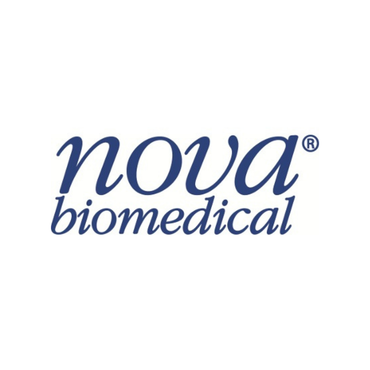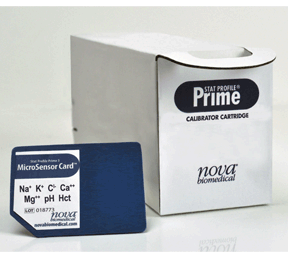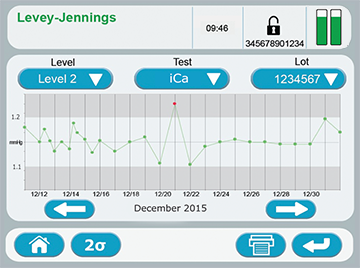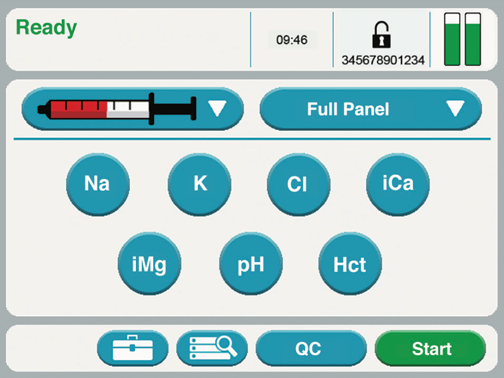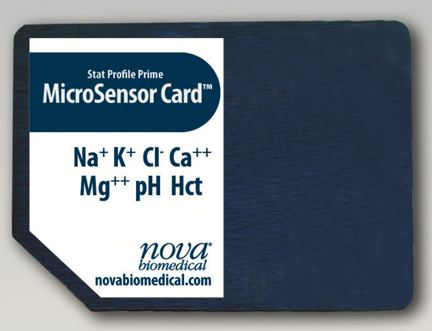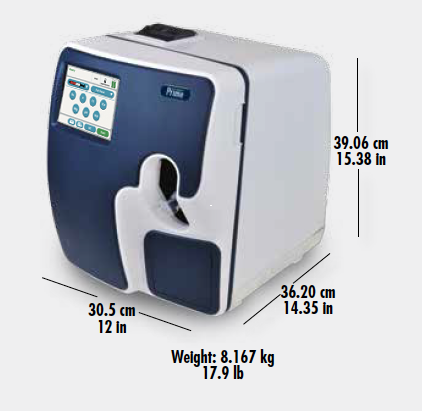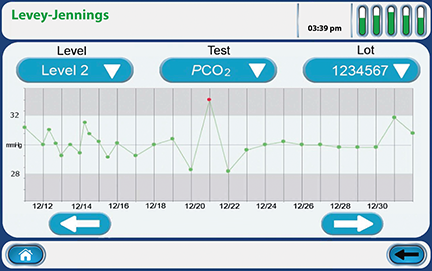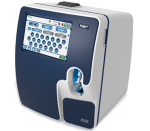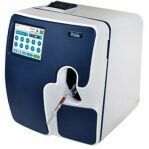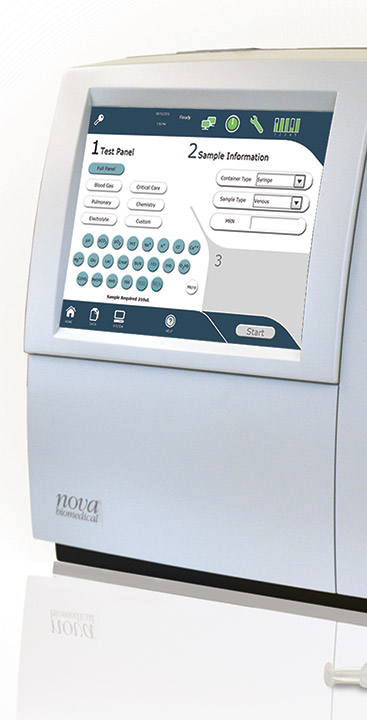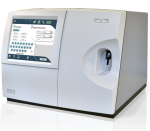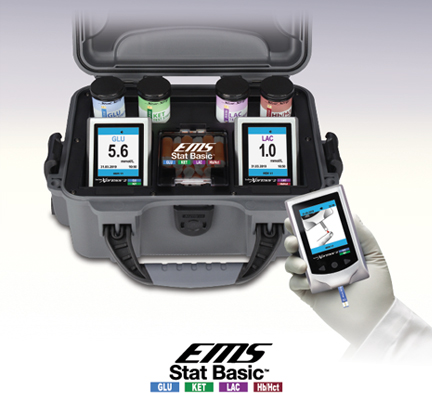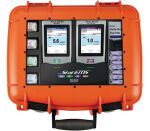該供應商提供更多產品
-
The only glucose meters cleared by US FDA and Health Canada for use with all patients, including critically ill
Because of the unacceptably high rate of adverse patient events, including deaths, linked to the point-of-care (POC) use of glucose meters within hospitals, there is a recognized need for more accuracy and better performance standards for POC glucose testing in hospitals, particularly in intensive care settings.
StatStrip is designed specifically to measure and correct for clinical interferences that can be present in critically ill patients.
Proven safety and accuracy- In one study of over 17,300 capillary results from critically ill patients that were compared to lab results
- In another study of 1,698 arterial and venous results from critically ill patients with over 257 medical conditions were compared to lab results
- Improved accuracy results in less insulin misdosing and better outcomes for critically ill patients
Use of any other meter with critically ill patients is considered off label in the U.S. by the FDA and high complexity testing under CLIA
Use of any other glucose meter with critically ill patients is off label
StatStrip is FDA and Health Canada cleared and CLIA waived for use throughout all hospital and all professional healthcare settings including critical care. Use of any other glucose meter with critically ill patients is considered off-label in the U.S. by the FDA and high complexity testing under CLIA.The personnel testing requirements for off-label use are very demanding and limit who can perform testing. In addition, a hospital must obtain patient consent to perform off-label testing.
The most extensively studied and proven glucose measurement technology
In addition to the studies submitted to the FDA, 168 other independent studies over the last eight years—including 53 critical care studies—have found no clinically significant interferences for StatStrip. This is a statement that no other glucose meter manufacturer can make. Download a bibliography of publications hereFor more information click here
"> -
Not yet available in the U.S.
The most extensively studied and proven glucose measurement technology
In addition to studies submitted to the FDA, 168 other independent studies over the last eight years—including 53 critical care studies—have found no clinically significant interferences for StatStrip's measurement technology. This is a statement that no other glucose meter manufacturer can make. StatStrip and StatStrip Xpress2 are the world’s most extensively studied and proven glucose test. It has been proven to be safe and effective for use throughout all hospital and professional healthcare settings including critical care.
Wireless meter connectivity to LIS/HIS with StatStrip Glucose/Ketone
The StatStrip Glucose/Ketone Hospital Meter System offers bidirectional wireless connectivity to hospital HIS or LIS with complete security to protect patient data.
- Wireless connectivity can transmit patient results directly from the bedside, alleviating the need to bring the meter to a fixed location for meter docking and data transmission.
- Wireless connectivity saves time for the caregiver and allows for faster charting of results and clinical decision making to improve patient care.
- Dual-band wireless connectivity provides complete security and encryption to ensure that patient data remains uncompromised.
- Nova now offers a full range of StatStrip Glucose/Ketone wireless connectivity capabilities, including wireless meters, wireless carrying cases, and wireless docking stations.
- All wireless devices use the industry standard POCT1-A2 data format and are compatible with a choice of middleware partners.
Measures ketones* with same meter
Easy to use
No meter preparation or calibration coding steps are required. Insert a ketone strip and StatStrip Glucose/Ketone meter automatically recognizes the strip and converts the meter to ketone measuring mode.Blood ketone testing should be performed whenever glucose exceeds 14 mmol/L (250 mg/dL)
Diabetes UK, the Canadian Diabetes Association, the European Society for Paediatric Endocrinology, and the American Diabetes Association (ADA) recommend that blood ketone testing be performed whenever glucose exceeds 14 to 17 mmol/L for rapid detection or prevention of diabetic ketoacidosis (DKA).StatStrip Glucose/Ketone measures blood beta-hydroxybutyrate, the preferred ketone for diagnosing ketoacidosis
According to the European Society for Paediatric Endocrinology, Diabetes UK, ADA, and others, blood ketone testing methods that quantify beta-hydroxybutyrate, the predominant ketone body in DKA, are recommended over urine ketone testing for diagnosing and monitoring ketoacidosis.Ketone testing results obtained from capillary samples
Capillary blood samples are not only preferred over urine samples to detect and monitor DKA,
they are also easier to obtain and allow for immediate reflex testing of ketones whenever glucose is greater than 14 mmol/L.Blood ketone monitoring reduces costs and ICU length of stay for DKA patients
An ICU study evaluated the effectiveness of blood ketone testing versus urine ketone testing for DKA patients. The blood ketone testing group of patients left the ICU 6.5 hours earlier than the urine ketone testing group. This led to savings of 22 hours of nursing time and 375 laboratory investigations, for a total savings of €2,940.1A second study of DKA patients compared a DKA therapy endpoint of pH > 7.3 and blood ketones < 1.0 mmol/L, versus an endpoint of pH > 7.3 and negative urine ketones. The pH/ blood ketone endpoint was reached after 17 hours, whereas the pH/urine ketone endpoint was not reached until 28 hours after starting treatment. The mean lag between the blood ketone and urine ketone groups was 11 hours, ranging from 1 to 36 hours.2
Blood ketone is more accurate than urine ketone testing
Blood beta-hydroxyburyrate testing indicates the patient’s status at the time of the test, whereas urine may have been in the bladder for several hours. Urine testing can also produce false positive or negative results due to highly colored urine, highly acidic urine, exposure of the urine test strips to air for prolonged periods, drugs such as the ACE inhibitor captopril, or high doses of vitamin C.*Ketone testing is not available with StatStrip meters in the U.S. Glucose is available.
Learn more
In order to help hospitals avoid the risk of glucose meter off-label use, Nova Biomedical’s technical support resources are ready to help you acquire the StatStrip Glucose Hospital Meter System. To learn more about how StatStrip Glucose can bring critical care testing to the bedside, contact your current GPO or call Nova at 800-458-5813.
"> -
Fingerstick Capillary Blood Testing for Lactate, Hb, and Hct
The StatStrip Lactate and Hemoglobin/Hematocrit Meter system (StatStrip LAC/Hb/Hct) is a handheld, easy-to-use meter system that measures LAC, Hb and Hct at the point-of-care using two disposable biosensors and tiny capillary blood samples for all tests. StatStrip’s lactate biosensor provides lab-like accuracy in just 13 seconds from 0.6 microliters of capillary blood. StatStrip’s Hb/Hct biosensor accurately measures - not calculates - both Hb and Hct in 40 seconds from a 1.6 microliter capillary sample.
- Two pre-calibrated, disposable biosensors: Lactate and Hemoglobin/Hematocrit
- Capillary fingerstick blood samples as small as 0.6 μL
- Results as fast as 13 seconds
- Lab-like accuracy
Lactate, Hemoglobin, and Hematocrit
Lactate Testing Bedside
StatStrip LAC/Hb/Hct is a point-of-care (POC) system that enables rapid and timely trending of lactate in hypoperfusion during sepsis (or other conditions of hypoperfusion) for assessment of resuscitation or treatment efforts. Compared to testing with blood gas analyzers which require arterial samples, large samples volumes (up to 95 microliters), and long analysis times (up to 2.5 minutes); StatStrip’s single-use biosensor provides the fastest turnaround time (13 seconds) on the smallest whole blood sample (0.6 μL) with excellent correlation to central laboratory reference methods.Solves Lactate Pre-Analytical issues
Lactate is not stable in whole blood samples. Blood lactate levels rise steeply in less than 5
minutes if samples are transported or kept at room temperature.1 StatStrip point-of- care
testing ensures rapid, accurate results by eliminating sample transport preanalytical effects.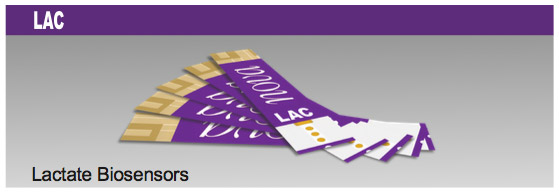
Hemoglobin and Hematocrit Testing Bedside
StatStrip LAC/Hb/Hct is the only POC system to provide anemia screening and monitoring with measured, not calculated, Hb and Hct tests. This important breakthrough is possible because of new, patented biosensor technologies developed by Nova Biomedical.
Accurate Assessment of Anemia
Accurate anemia evaluation requires both measured Hct and measured Hb. However, current POC Hb meters only provide a calculated estimate of Hct. Calculated estimates of Hct are inaccurate in many conditions including red cell structural abnormalities, hemolysis, hemoglobinopathies, and other conditions. These conditions necessitate measured Hct because calculated results can negatively impact treatment.
">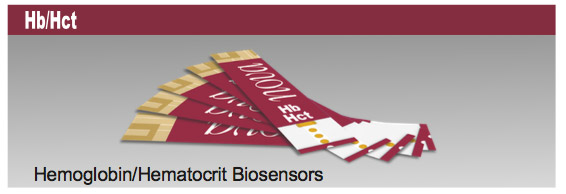
-
Features:
- Fastest turnaround – 13 seconds
- 0.6 μL whole blood sample
- Excellent correlation to central laboratory reference methods
The StatStrip Lactate Hospital Meter System is a handheld point-of-care testing system that brings lactate testing directly to the patient’s bedside.
Lactate is currently measured on blood gas analyzers, which creates numerous problems for bedside testing. Blood gas analyzers require anaerobic arterial samples, large sample volumes (100-200 microliters), and long analysis times (up to 2.5 minutes).
In addition, blood gas analyzers are complex to operate, fixed in location, and expensive to purchase and use for serial lactate testing.
StatStrip Lactate provides the fastest turnaround time possible (13 seconds), on the smallest whole blood sample (0.6 microliters), and can be easily operated by medical and nursing staff. StatStrip Lactate is a very low-cost device that makes lactate testing practical and affordable in any size ED, ICU, or medical unit. It is fully connectable to a hospital's IT system through NovaNet.
"> -
Simple Testing Procedure
- Place biosensor in meter
- Lance finger to create blood drop
- Apply blood drop to biosensor
- Read creatinine results
Benefits
- Virtually painless, 1.2 µL fingerstick capillary blood sample
- Creatinine and eGFR results in 30 seconds
- Cleared for use by point-of-care (POC) personnel
">
Radiology and cardiac catherization
Minimize risk of contrast induced nephropathy (CIN) – StatSensor Creatinine provides rapid, real-time renal assessment prior to contrast imaging.
Improve productivity and workflow – StatSensor Creatinine POC testing can prevent costly procedure room cancellations and workflow interruptions when patients arrive for imaging appointments without a current creatinine/eGFR workup.
Improve patient satisfaction – StatSensor Creatinine testing can prevent patient dissatisfaction when renal function must be determined before an imaging procedure and has not yet been tested when the patient arrives for the procedure.
Oncology
Reduce medication risks – Renal impairment is frequent in cancer patients, who are at high risk of chemotherapy-induced renal toxicity. StatSensor Creatinine provides important kidney function information for chemotherapy drug selection and dosing.
Improve patient satisfaction – Many cancer outpatients need to have their kidney function assessed before receiving their chemotherapy treatment. Obtaining a venous blood sample and sending it to a laboratory for creatinine/eGFR testing could delay chemotherapy for several hours. A chemotherapy treatment that might take a couple of hours could turn into a full day and cause patient dissatisfaction. With StatSensor Creatinine, a capillary blood sample can be obtained and renal function can be quickly determined.
ED: Improve patient triage, expedite patient care
Various triage patient care protocols in the emergency department may require rapid assessment of renal function in order to triage the patient. In addition, many ED therapies require timely administration of drugs and adjustment of drug dosage based on renal function. StatSensor Creatinine accurately assesses renal function with a simple, 30-second test that can be easily performed in the ED. -
New Technologies Simplify Use and Offer Additional Tests
Stat Profile Prime Plus is a comprehensive, whole blood critical care analyzer that combines blood gases, electrolytes, metabolites, CO-Oximetry, and 32 calculated results in a simple, compact analyzer. Prime Plus combines maintenance-free, component cartridge technology for sensors and reagents with patented, new, maintenance-free, and non-lysing whole blood CO-Oximetry technology.
Prime Plus results are produced rapidly, a complete test menu panel in about one minute, and are combined with bidirectional connectivity, a robust data management system, and comprehensive cybersecurity protection.
Nova MicroSensor Card™ Technology
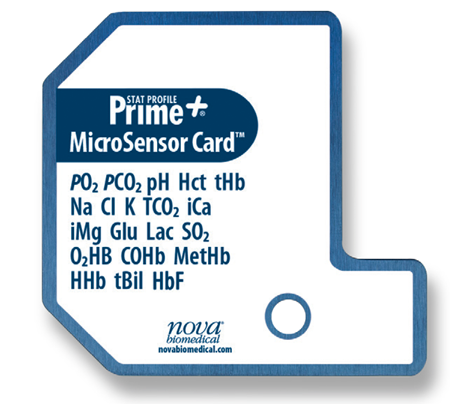
Most comprehensive critical care menu
PO2 PCO2 pH Hct tHb Na Cl K iCa TCO2 iMg Glu Lac Urea (BUN) Creat SO2% O2Hb COHb MetHb HHb- All Stat Profile Prime Plus biosensors use proven Nova technology in a miniaturized, maintenance-free sensor card format.
- Nova MicroSensor cards combine all 20 whole blood assays including CO-Oximetry.
Important New Assays
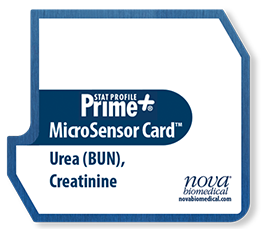
Urea (BUN), Creatinine and eGFR
Over 50% of patients admitted to the ICU will develop some stage of acute kidney injury (AKI).1 Stat Profile Prime Plus is the only blood gas analyzer to provide whole blood urea (BUN) and creatinine (plus eGFR) test options for rapid assessment of kidney function.
Ionized magnesium (iMg)
Disruptions in the balance of iMg, Na, K, and iCa can cause cardiac arrhythmias, reduced cardiac contraction, and cardiac arrest. Prime Plus is the only blood gas analyzer to provide a comprehensive profile of electrolytes including iMg.New Disposable CO-Oximetry Technology Eliminates Maintenance
Prime Plus incorporates a new, patented multi-wavelength optical system that scans a continuous spectrum of optical wavelengths to enable a comprehensive CO-Oximetry panel result without lysing the sample. The optical components in contact with blood are contained in the disposable sensor card.
- Cleaning and deproteinising are completely eliminated.
- Lysing and all its required mechanical components are eliminated, as are lysing and deproteinising reagents. This improves reliability and reduces maintenance and costs.
CO-Oximetry test menu
O2Hb COHb MetHb HHb tHbFast Stat Results
Prime Plus’s exceptional throughput easily handles the high sample workload of a busy critical care setting. Prime Plus delivers a 20-test critical care profile in about one minute. Competitors’ analyzers can require up to four minutes, even with fewer tests reported.
Clot Protection
Prime Plus’s unique Clot Block™ sample flow path protects sensor cards from blood clot blockages.
Bidirectional Connectivity Patient Management
NovaNet bidirectional middleware for all Nova connected devices
NovaNet ensures timely, accurate capture of Nova analyzer test results for clinicians and managers to retrieve wherever and whenever needed. Also included is comprehensive cybersecurity protection and encryption that provides protection against attempts to access a hospital's network.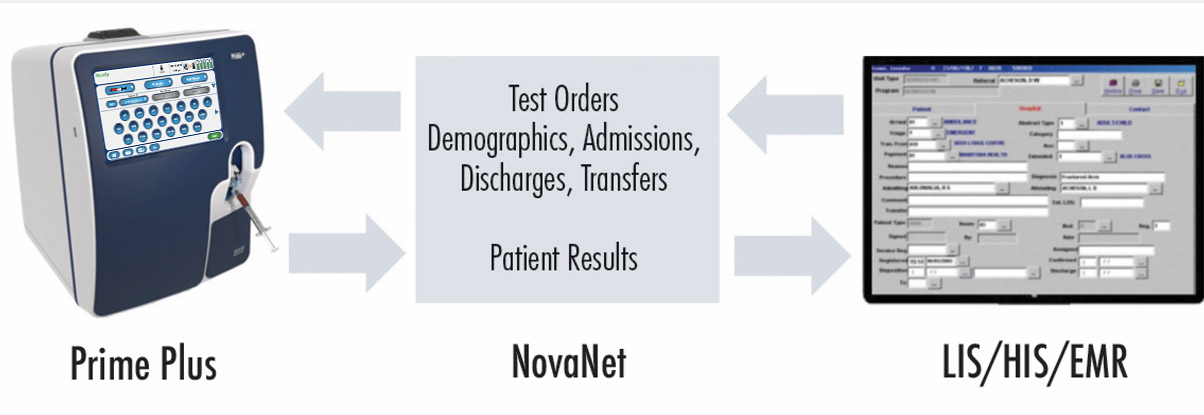
Automated, True Liquid QC
Liquid QC provides the only reliable test of analyzer performance
United States federal government regulations and many international government regulations have eliminated electronic equivalent QC and are requiring true liquid QC.2Automated QC complies with U.S. CLIA, German RiLiBAK, and other international QC requirements
QC cartridges contain a 30-day supply of liquid QC material. Controls are run automatically at user-selected intervals. Prime Plus quality controls:- Are comprised of a similar matrix to that of patient samples.
- Are treated in the same manner as patient samples.
- Follow the exact sample pathway as patient samples, from sample probe to waste container.
- Challenge all analytical phases of testing.
- Challenge testing at patient low, normal, and high value ranges.
Supplemental Quality Monitoring (SQM)
Prime Plus provides an automated electronic quality monitoring supplement to liquid QC. SQM continuously monitors the status and performance of all analytical components (including sensors, reagents, calibrators, sample integrity, software, and electronics), providing real-time, sample-to-sample assurance of correct performance.
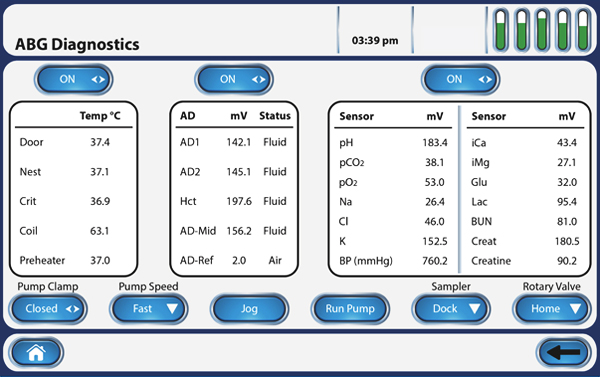
"> -
The New Definition of Simplicity for Critical Care Testing
Measures: pH PCO2 PO2 Na K Cl iCa Glu Lac Hct
Stat Profile Prime combines the revolutionary microelectronics of the consumer world with Nova Biomedical’s innovative MicroSensor Card™ technology for a smaller, faster, more powerful yet simpler and less expensive analyzer.
Maintenance-free cartridge system
Stat Profile Prime’s unique cartridge system consists of individual cartridges for sensors, calibrators, and liquid quality control (QC).
Maximum analyzer uptime
Individual cartridges offer a significant benefit in analyzer uptime compared to combined sensor/calibrator cartridge systems.
Cartridge replacement in seconds
Each cartridge is ready to use and easily replaced in seconds. Cartridge RFID technology automatically captures cartridge installation time, date, lot number, test parameters, and usage. There is significant savings in analyzer uptime when replacing only a calibrator cartridge, which has no warm-up time, compared to a two-to-four-hour wait for combined cartridge systems.
Individual cartridges lower costs
Individual cartridges offer a low-cost alternative compared to the inflexibility and waste of combined cartridge systems. For example, an analyzer used in a high volume setting will require fewer sensor cartridges than calibrators, but a low volume setting will require the reverse. In both cases, costs are reduced by using Stat Profile Prime’s individual sensor and calibrator cartridges, which have no waste compared to combined cartridge systems.
MicroSensor card technology
Accuracy
All Stat Profile Prime tests use proven Nova biosensor technology in a miniaturized, sensor card format.Constant stat readiness
MicroSensor cards have flexible configurations:- 200 Samples
- 400 Samples
MicroSensor cards are automatically calibrated and always ready for immediate analysis.
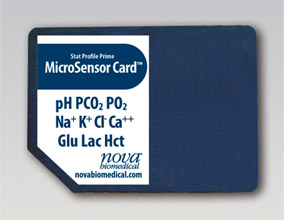
Clot protection
The unique Clot Block™ sample flow path is designed to protect sensor cartridges from blood clot blockages.Fastest replacement time
MicroSensor cards can be replaced, warmed, and calibrated in less than half the time of other cartridge systems, which take more than an hour to calibrate and can remain unstable with drift, frequent re-calibrations, and reduced throughput for even longer periods of time.Automated, true liquid QC
True liquid QC provides the only reliable test of an analyzer
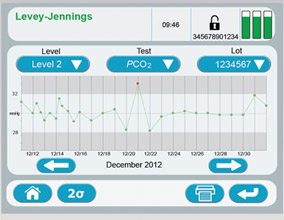
In the U.S., federal government regulations (CLIA) are phasing out electronic QC and are requiring true, liquid-based QC. Stat Profile Prime combines both automated, true liquid QC and continuous electronic self-monitoring to ensure lab accuracy and uncompromised quality.
Tri-level QC cartridges automate daily QC
QC cartridges contain a 30-day supply of liquid QC material. Controls are run automatically at user-selected intervals. An optional QC lockout feature disables any analyte that is not within QC limits.CLIA QC compliant out of the box
Stat Profile Prime’s automated QC system complies with all new CLIA requirements.1 Liquid quality controls follow the identical sample pathway as the blood sample and confirm the entire analytical process for each analyte at multiple levels of concentration. QC statistics are automatically maintained.Complete automation
Running QC manually is one of the most time consuming aspects of critical care testing. Stat Profile Prime’s automated, true liquid QC saves hours of time each week, eliminating the need to develop, implement, and document a lengthy, risk-based quality assessment and individualized QC plan.Supplemental quality monitoring
Stat Profile Prime provides a supplement to liquid QC by continuously monitoring the status and performance of all analytical components (including sensors, reagents, calibrations, sample integrity, software, and electronics) providing real-time, sample-to-sample assurance of correct performance.
10 critical care tests – results in 60 seconds
- pH PCO2 PO2 Na K Cl iCa Glu Lac Hct
- Fast throughput: Up to 45 samples/hour
- Arterial, venous, or capillary micro-samples: 100 microliters for full menu
Bidirectional connectivity
Stat Profile Prime's bidirectional software uploads patient and QC results to hospital and laboratory information systems using ASTM or POCT1-A2 formats. The bidirectional interface also enables downloading of test orders, patient identifiers, and patient demographics from the LIS or HIS to Stat Profile Prime. Complete, accurate test records are seamlessly captured for the medical record. Also included is comprehensive cybersecurity protection and encryption that protects PHI and provides an added level of protection against for attempts to access a hospital's network.
Safe, simple, fast operation
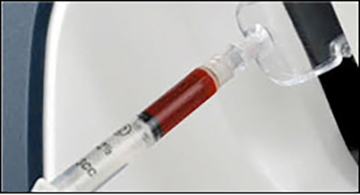 Syringes can be docked and sampled with
Syringes can be docked and sampled with
hands-free operation.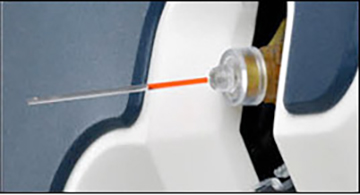 Hands-free capillary sampling can be performed
Hands-free capillary sampling can be performed
without adapters.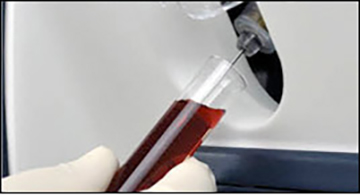 Samples can be aspirated directly from tubes,
Samples can be aspirated directly from tubes,
eliminating sample transfer to a syringe or capillary.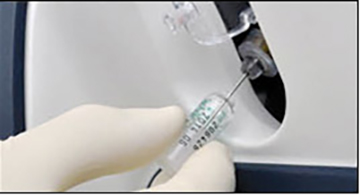 QC proficiency ampules can be sampled without adapters.
QC proficiency ampules can be sampled without adapters.Easy sampling from syringes, capillaries, tubes, and ampoules
A unique safety sample port protects the user from accidental contact with the sample probe and is easily accessed for all sample containers.Easy-to-use, high-definition, color touchscreen
The touchscreen is easily operated through the use of simple and intuitive prompts and requires minimal training.Three simple steps to initiate a full 10-test profile
- Press “Start”
- Scan or enter patient ID
- Press “Aspirate”
Integrated barcode scanner
The 1D/2D barcode scanner, conveniently located within the sample port allows for fast, error-free entry of operator and patient IDs. The optional, wireless, external barcode scanner also allows for positive patient ID, further eliminating pre-analytical error.
"> - *Not yet available in all markets
The Most Comprehensive Critical Care Analyzer
One analyzer, up to 20 tests
No other blood gas analyzer can match the clinical value of pHOx Ultra, which provides up to 20 critical care tests from one small, 210-microliter sample in only 2 minutes. Other partial test panels are available in less than one minute. Measured tests include: pH PCO2 PO2 SO2% Na K iCa iMg Cl Glucose BUN/Urea Creatinine Lactate Hct Hb O2Hb HHb COHb MetHb tBil
Customized Menus
pHOx Ultra can be custom configured with as few as 5 tests to as many as 20 tests to satisfy the exact test menu requirements of each department. However the complete test menu does not have to be run on each sample. Up to 30 specific user-defined subsets (panels) can be created for patient populations such as pulmonary, surgical, pediatric, or emergency care.
Easy-to-Use, Color Touchscreen
pHOx Ultra incorporates an intuitive, high-resolution color touchscreen. This new user interface is fast and easy to use with graphic icons and visual prompting through its simple three-step operation:
- Select tests
- Identify the sample
- Aspirate the sample
New High-Resolution Color Display
Phox Ultra incorporates a large, high-resolution color display. The large format, bright colors, and high resolution provide exceptional viewing, and easy-to-read graphics and data.
Comprehensive On-board Data Management System
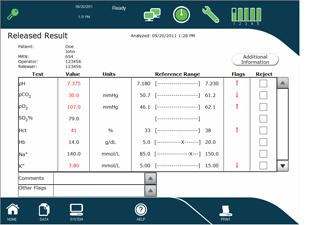
A standard feature on all Stat Profile pHOx Ultra analyzers is a complete on-board Data Management System, allowing data capture and extensive reporting capabilities including:
- Storage and retrieval of patient results, patient demographics, QC, and authorized users
- Data retrieval by name, ID, date, location, or operator
- Patient, QC, utilization, and operator reports
Analyzer Networking At No Extra Cost
Multiple pHOx Ultra analyzers can be networked together into a single, common database. A supervisor or authorized operator can access all patient results, QC results and reports from all analyzers. Competitors often offer this capability only as an expensive accessory, adding 30% – 40% to the cost of the analyzer.
Remote Set-up and Control
pHOx Ultra offers comprehensive, time-saving remote set-up, control, and review of multiple pHOx Ultra analyzers. From any point on the LAN, a manager can perform the following functions on a remote analyzer:
- Review reagent cartridge and QC cartridge status
- Review instrument calibration status
- Initiate a calibration cycle
- Review QC status
- Initiate a QC cycle
- Enable or disable an analyte
- Enable or disable operator access
- Edit normal ranges, critical ranges, QC ranges, QC frequency, operators, test menu, instrument defaults
Connectivity
pHOx Ultra analyzers are compliant with industry standard POCT1-A2 and ASTM communication protocols for connectivity. These industry standards are used to easily interface pHOx Ultra analyzers to a wide range of connectivity systems including LIS, HIS, and middleware systems.
Automated, True QC
An automated, true QC system eliminates all user steps involved in performing multi-level, true liquid QC, dramatically reducing labor while maintaining the most stringent QC.
Measured SO2%, Hb, and Hct on Each Sample Without CO-Oximetry
A unique technology feature of pHOx Ultra analyzers is the ability to measure hemoglobin, hematocrit, and oxygen saturation on each sample. Advanced biosensors, optics, and algorithms enable measurement of these parameters without the added cost, hardware, and sample volume of a CO-Oximeter.
Optional On-Board CO-Oximeter
When a complete profile of hemoglobin fractions is needed as part of the analyzer test menu, pHOx Ultra offers an on-board CO-Oximeter with advanced features:
- Complete CO-Oximetry test panel including O2Hb, HHB, COHb, MetHb, tBil
- Automatic calibration
- Automatic cleaning of the optical components
Ionized Magnesium
pHOx Ultra provides ionized magnesium as part of its electrolyte panel. Ionized magnesium is a very important electrolyte for cardiac health. This electrolyte works with potassium and calcium to maintain strong and rhythmic cardiac contraction. It is the most common electrolyte abnormality among post operative intensive care patients.
Exceptional Reliability
Stat Profile pHOx Ultra hardware and software designs are based on the extraordinary reliability of previous generation pHOx analyzers that have been proven in thousands of installations during the last decade.
Multiple Department Applications
The customizable whole blood test menu, fast analysis time, and low operating cost make pHOx Ultra ideal for multiple testing locations:
- OR, ICU: Provides the most comprehensive menu for managing high acuity ICU and OR patients
- Emergency Department: Reduces waiting times for essential laboratory tests, improving patient triage and satisfaction
- Stat Lab: Supports the stat testing workload of multiple departments
- Mobile Testing: pHOx Ultra on a mobile cart with battery backup enables it to be moved to any hospital location for stat testing as needed
Low Cost Critical Care Testing
pHOx Ultra combines long life sensors plus low cost reagent cartridges to provide the most cost effective way for a hospital to offer critical care blood gas testing. pHOx Ultra provides a 20-test critical care profile at a cost equivalent to testing performed in the central laboratory. Other point-of-care devices that use single-test or 30-day sensor cartridges can be 5-to-10 times more costly.
The pHOx Ultra comprehensive on-board Data Management System eliminates the high cost of purchasing a separate data manager. The Data Management System enables networking of multiple pHOx Ultra analyzers, reducing connectivity and record keeping costs.
">
Lactate, Hemoglobin, Hematocrit, Glucose, and Ketone for early patient assessment and treatment
- Fingerstick capillary sample, no blood draws
- Results as fast as 6 seconds
- Laboratory-quality accuracy
- Durable carrying case holds meters, single-use biosensors, controls, and lancets
- Meters store and transmit patient data
Stat EMS can measure lactate, hematocrit, hemoglobin, glucose, and ketone from a capillary blood drop. Results are available in seconds by using single-use biosensors and portable meters. Stat EMS offers simple, fast, and accurate testing in the field.
Two meter systems are available. One provides patient data storage plus wireless connectivity to external data managers, the other provides data storage only.
Test Menu
Stat EMS provides important tests to help patient assessment, and emergency treatment. These tests can also help determine the appropriate transport site for patients with trauma, sepsis, or other specialized needs.
Elevated blood lactate is a rapid, sensitive indicator of tissue hypoxia, sepsis, septic shock, and hypovolemic shock.7-9
For ambulance patients, lactate testing provides:
- Early, more sensitive detection of hypoperfusion during sepsis and septic shock than vital signs alone8
- Identification of patients with sepsis who might benefit from early goal-directed therapy and advanced activation of medical staff at the transport site10,11
- Evaluation of trauma, critical illness, hemorrhage, acute coronary syndrome, acute respiratory failure, and chest and abdominal pain11,13
Abnormal glucose levels are frequently encountered in ambulance patients. Medical conditions that warrant pre-hospital blood glucose testing include diabetes, altered mental state, seizure, acute coronary syndrome, organ injury, trauma, sepsis, septic shock, and burns.1-3
Ketone
Blood ketone testing provides rapid detection or rule- out of diabetic ketoacidosis (DKA), the leading cause of hospitalization and death for children with diabetes.4The American Diabetes Association and International Society for Pediatric and Adolescent Diabetes recommend blood ketone testing whenever glucose is above 14 mmol/L (250 mg/dL).5,6
Stat EMS provides accurate, measured results for both hemoglobin and hematocrit for pre-hospital assessment of blood oxygen carrying capacity for:
• Evaluation of internal or external hemorrhage
• Assessment of the need for blood products14,15
• Estimation of blood loss
Fingerstick Sampling
Using capillary samples as small as 0.6 μL, Stat EMS provides fast and easy testing for high-stress medical situations. Capillary sampling and testing with Stat EMS is as easy as glucose self-testing performed by patients with diabetes. It eliminates the time and costs of a venipuncture, including the tourniquet, needle, vacutainer, and transfer pipette—as well as finding a suitable vein.
Simple to Use
Stat EMS meters do not require coding or calibration before use and are fast and easy to use.



Results in Seconds
With fast, simple testing steps and ready to use biosensors, Stat EMS provides results in 6 to 40 seconds after the fingerstick depending on the assay.
A Choice of Two Models
Stat EMS Data Link, Connectivity and Data Storage
The connectivity meters store up to 1,000 patient results and offer Bluetooth connectivity. They offer comprehensive point-of-care features including operator and patient ID, preset or customized test result comments, quality control prompting and lockout for unauthorized use. The meters feature touchscreen operation and a bright color display.
Stat EMS Data Link, Carrying Case
The case is rugged, compact, and contains all testing components, including meters, biosensors, controls, and lancets. It also serves as the battery charging station for the meters. It is water resistant and designed to protect all components if dropped. It is available with an adjustable shoulder strap.
Stat EMS Basic, Data Storage
The Basic meters store up to 400 test results with a date and time stamp plus first in/first out sequential numbering for sample identification. The meters feature touch sensi- tive buttons for operation and bright color screens.
Stat EMS Basic, Carrying Case
The case is rugged, compact, and contains all testing components, including meters, biosensors, controls, and lancets. It is water resistant and designed to protect all components if dropped. An adjustable shoulder strap is available.


